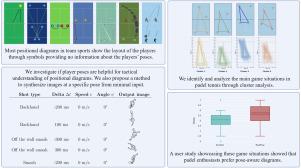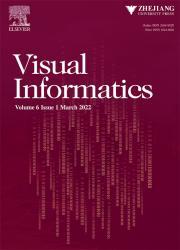可视化特定时间的游戏动态:玩家姿势对模式战术分析的影响
IF 3.8
3区 计算机科学
Q2 COMPUTER SCIENCE, INFORMATION SYSTEMS
引用次数: 0
摘要
战术因素在团队运动中是至关重要的。对假想游戏情境的分析很大程度上得益于显示玩家所在位置的位置图。这些图表通常通过简单的符号来显示玩家的布局,而这些符号并没有提供关于他们姿势的信息。本文研究了球员姿态的可视化是否有助于战术上对牌位图的理解。我们提出了一个逼真的、卡通式的玩家表示,并讨论了将其整合到一个典型的位置图中。为了克服生成描绘姿态的玩家表示的成本,我们提出了一种从最小用户输入生成这种表示的方法。我们进行了一项用户研究来评估姿势感知图的有效性。这项研究的任务被设计成包含主要的游戏场景,其中包括持球者在网前与对手防守,相反的情况,以及这两种状态之间的转换。我们发现我们的表现方式比只表明玩家方向的象征性表现方式更受欢迎。所提出的方法使教练能够在几秒钟内产生这样的表示,从而大大促进了对比赛情况进行详细且易于分析的描述的创建。本文章由计算机程序翻译,如有差异,请以英文原文为准。

Visualizing game dynamics at a specific time: Influence of the players’ poses for tactical analyses in padel
Tactical elements are crucial in team sports. The analysis of hypothetical game situations greatly benefits from positional diagrams showing where the players are. These diagrams often show the layout of the players through simple symbols, which provide no information about their poses. This paper investigates if the visualization of player poses is beneficial for tactical understanding of positional diagrams in padel. We propose a realistic, cartoon-like representation of the players and discuss its integration into a typical positional diagram. To overcome the cost of generating player representations depicting their pose, we propose a method to generate such representations from minimal user input. We conducted a user study to evaluate the effectiveness of our pose-aware diagrams. The tasks for the study were designed to encompass the main in-game scenarios in padel, which include the ballholder at the net with opponents defending, the reverse situation, and transitions between these two states. We found that our representation is preferred over a symbolic one that only indicates player orientation. The proposed method enables coaches to produce such representations within a matter of seconds, thereby significantly facilitating the creation of detailed and easily analyzable depictions of game situations.
求助全文
通过发布文献求助,成功后即可免费获取论文全文。
去求助
来源期刊

Visual Informatics
Computer Science-Computer Graphics and Computer-Aided Design
CiteScore
6.70
自引率
3.30%
发文量
33
审稿时长
79 days
 求助内容:
求助内容: 应助结果提醒方式:
应助结果提醒方式:


